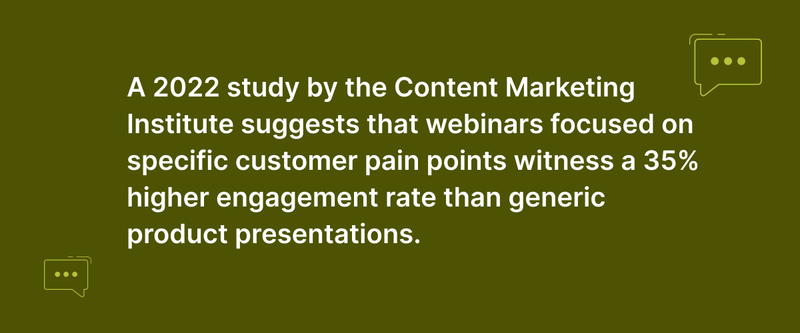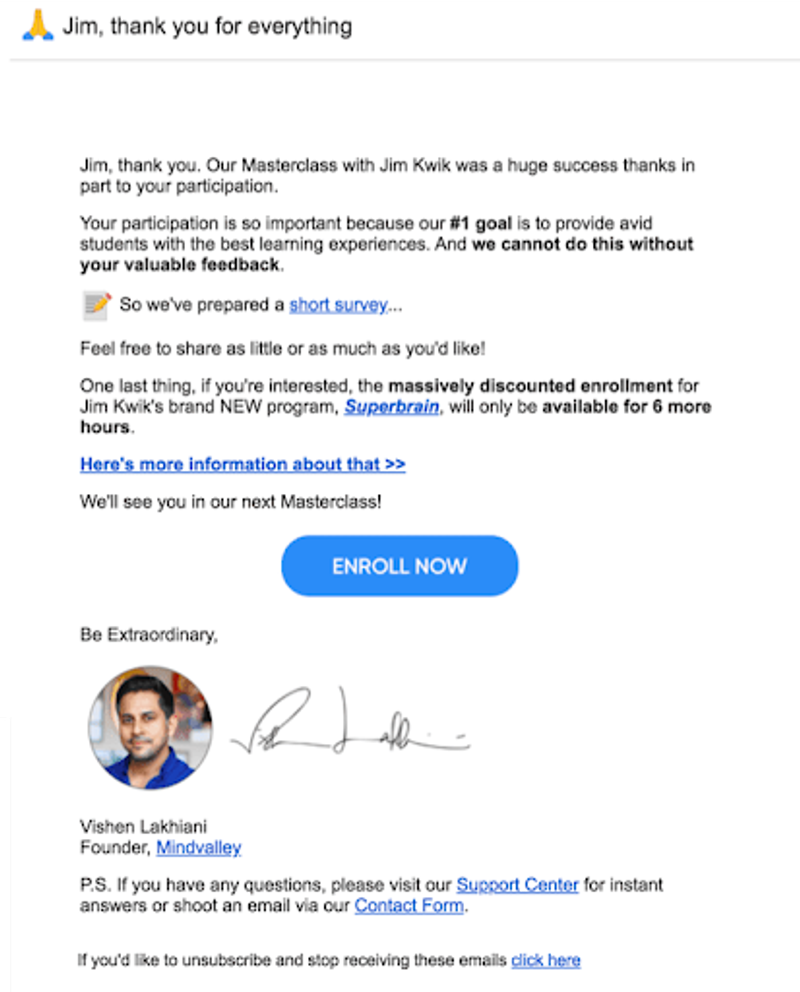How SaaS Companies Can Use Webinars to Drive Product Adoption
Table of Contents
Maximize Your Marketing ROI
Join 10,000 other marketers already getting the best tips on running engaging events that boost pipeline and create raving fans.
The SaaS world is changing as businesses look to redefine themselves from boring software companies to more interactive brands. Such transformation requires bridging the gap between product innovation and user adoption, which presents a unique challenge.
As these digital solutions become more sophisticated, effective user education and engagement strategies need to become top priority. But how can you do this in a way that is engaging, interactive, and scalable?
Welcome to the world of product adoption focused webinars!
These types of webinars can be a potent tool in a SaaS marketer’s arsenal if used strategically. They offer an interactive platform for SaaS companies to showcase their offerings, directly engage with potential customers, and build trust and understanding with current users.
In this piece, we’ll dive into how SaaS companies can leverage webinars to catalyze product adoption, transforming potential and current users into loyal and long-term customers.
#1. Create webinar content that demonstrates product utility
Craft webinar content that aligns directly with users' needs and pain points. This involves thorough market research to understand your potential and current customers' challenges and how your product can be the solution.
The key to effective webinars is relevance. So, provide content that resonates with the audience. This holds their attention and demonstrates the product's tangible value in their professional or personal lives.

Here’s how to get started:
- Conduct surveys or interviews with existing customers to gather insights on common challenges. Here’s more on getting started with virtual event customer survey questions to make the most out of that effort.
- Drive the webinar’s narrative around use-case scenarios or success stories showcasing how your product addresses these challenges.
- Example: Slack’s webinars often showcase real-life business scenarios in their webinars to demonstrate how their tool facilitates better team collaboration and communication.
#2. Host interactive Q&A sessions
Incorporate live Q&A sessions in your webinars. This interactive segment allows potential customers to ask questions and get immediate responses, creating a two-way communication channel.
When prioritizing customer interactions, the Q&As will clarify doubts and build community and trust. It also reflects your brand’s philosophy of valuing customer input and keeping things transparent about product capabilities.
Fact file: A whooping 82% of webinar attendees prefer a live Q&A session at the end, emphasizing the importance of interactive segments
Quick tips on implementing Q&A sessions within your webinar:
- Encourage questions throughout the webinar. Don’t just keep them at the end to ensure two-way communication throughout the event.
- Prepare for common questions, but also be ready for on-the-spot problem-solving.
- Bring in the mix the real-time polls during the webinar to collect instant feedback or questions. This helps make the session more dynamic, giving a sense of immediacy and interaction.
- Example: Slido hosts 90-minute all-hands meetings wherein 30 minutes are allocated to answering questions from their teammates.
Hosting a webinar where customers’ privacy is exposed may lead you to needing a cybersecurity solution like CAASM. Such a proactive approach will secure customer data, personal information shared during Q&As, and other webinar data. Such an approach helps prevent security mishaps that can dent your brand image.
#3. Consider leveraging post-webinar engagement
Think of what you can provide and even extract after the webinar concludes. The idea of the webinar is to extend the engagement beyond the webinar. Therefore, follow-up communications like emails, sending personalized ecards to webinar attendees as a creative and memorable way to express appreciation for their participation, providing access to additional resources or scheduling one-on-one discussions for more detailed inquiries make up for further engagement.
Effective post-webinar follow-ups can also contribute to revenue marketing in the SaaS domain. To further explore the revenue marketing meaning, it is a framework where you align sales and marketing efforts towards generating revenue. These follow-ups aim to convert webinar engagement into tangible business outcomes like increased product adoption and upselling other products.
Such an approach helps maximize Return on Marketing Investment (ROMI) by connecting marketing efforts directly to revenue generation. And this can transform marketing from a cost center to a profit center.
Moreover, continued interaction helps build on the rapport created with users during the webinar. So, build on that momentum and capitalize on engagement to get the feedback and fine-tune the product to ensure easier adoption.
Fact file: 99Firms states that 62% of buyers will request the product demo after the webinar, which means effective follow-ups could increase lead conversion rates.
Tips for effective post-webinar follow-ups:
- Adopt a SaaS email marketing strategy that sends tailored follow-up emails with key takeaways and additional resources. This helps in nurturing leads and getting your trials to the aha moment.
- Invite attendees to join exclusive online communities or forums that foster a sense of belonging and provide a platform for continuous learning and engagement.
- Offer exclusive access to extended trials or demos of your product for webinar attendees.
- Example: Mindvalley sends post-webinar emails with a survey to know customer experience and work on it for better product adoption

These tips can enhance the impact of your post-webinar engagement by offering continued value to the attendees. It also fosters stronger connections with potential customers.

#4. Drive webinar optimization with analytics
Analyze webinar data to gain insights into attendee behavior, content engagement, and overall effectiveness. This data-driven approach aids in refining future webinars.
Most webinar platforms offer comprehensive analytics dashboards that track a range of metrics. First, ensure your webinar tool provides detailed attendee behavior and engagement reports.
These reports often include data on registration numbers, attendee login times, duration of attendance, interaction rates with the content (like poles or Q&A sessions), and drop-off points.
Key Performance Indicators (KPIs) to monitor:
Attendee Duration and Engagement: This metric indicates the content's relevance and presentation quality. High drop-off rates at specific points can signal areas that need improvement.
Interaction Rates: Monitor how attendees interact with the webinar. Are they participating in polls, asking questions, or downloading the offered resources? These interactions are strong indicators of how engaging and useful the content is.
Conversion Metrics: Post-webinar, it's crucial to track conversion metrics. This includes the number of attendees who took a desired action post-webinar, such as signing up for a trial, requesting a demo, or purchasing.
Interpreting these metrics involves looking for patterns and correlations.
For example, the content could be more engaging and complex if many attendees leave during a particular segment. Similarly, high interaction rates during a specific topic suggest that the content resonates well with the audience.
The final step is translating these insights into actionable strategies. If a certain type of content (like case studies or live demos) shows higher engagement, consider incorporating more in future webinars.
Fact file: BusinessNewsDaily reports Forrester on how companies that excel in nurturing leads can generate 50% more sales-ready leads at a 33% lower cost. And this is where you will see how analytics make a difference.
![[object Object]](https://cdn.sanity.io/images/2939l4aj/production/1b4075781ed971be729e4bc973cf4134bb10d886-1200x350.png?w=800)
#5. Adopt storytelling in your webinar content
Indulge in storytelling to empower your webinar content and hold users’ attention. This means you’ll go beyond just listing features and weaving a narrative demonstrating how your product can impact their business operations.
With storytelling in webinars, you’ll make the content more relatable in terms of helping them visualize the practical benefits of the product to simplify product adoption.
How do you blend storytelling into a product adoption webinar?
- Ask your existing customer base to share their experiences and success stories. Pick up various stories that reflect different aspects of your product's use.
- Add some emotional elements to your stories, showing how users felt after solving a persistent problem or the excitement of achieving a goal using your product.
- After the webinar, share content related to your stories, like a case study, a blog post, or a video testimonial.
- For instance, Dropbox often uses customer success stories in its webinars to illustrate how its service simplifies data storage and collaboration.
Improve product adoption with webinars
When you are looking to promote product adoption, webinars often pave the way to deepen your connection with customers. These webinars require thoughtful planning and deep understanding of the audience. The focus should be on delivering genuine value to simplify your SaaS product adoption. Done effectively, webinars can transform from mere content marketing tools into powerful catalysts for growth and customer loyalty in the SaaS industry.
Stay In Touch
Platform
Resources
Company
Community
© 2024 Copyright Goldcast, Inc. All rights reserved.